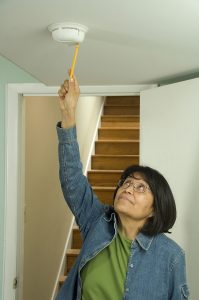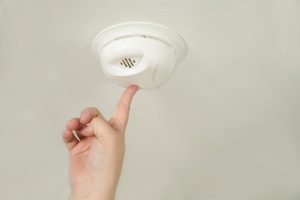Both smoke alarms and carbon monoxide alarms should be tested at least once a month! This is true even for hard-wired/interconnected alarms, since the alarm itself can fail despite it still having battery or electrical power. Push the test button for a few seconds until it beeps loudly to indicate that the alarm is working. (If you can’t safely use a ladder, you may be able to do this by using a pencil, broom handle or wooden spoon to reach up to the alarm.) Conduct this test on each and every alarm, every month.

We recommend making this a family activity, which will encourage everyone to stay familiar with the sound of the alarm and what actions to take when you hear it as part of your “home escape plan.” Follow the manufacturer’s instructions for your alarms.
If an alarm does not make a long, loud beep when you hold down the push button for several seconds, typically your first step in “trouble-shooting” will be to replace the battery then conduct the same test again. If your alarm still fails the push-button test after installing a fresh battery, double-check that the smoke alarm is not more than 10 years old … and the CO alarm is not more than 5-7 years old. (The date of manufacture should be displayed on a small stamp or sticker on the back of the alarm; smoke alarms are designed to be replaced at least every 10 years, and CO alarms are designed to be replaced every 5 to 7 years.) If you believe your alarm has exceeded its reliable lifespan, your next step in trouble-shooting would typically be to replace the actual alarm, and consider doing so for ALL alarms in your home simultaneously so they are all the same age. However, if you believe an power outage or other problem with your electrical supply may have tripped up your hard-wired alarms, consider resetting the breakers and/or calling a certified electrician for assistance.
